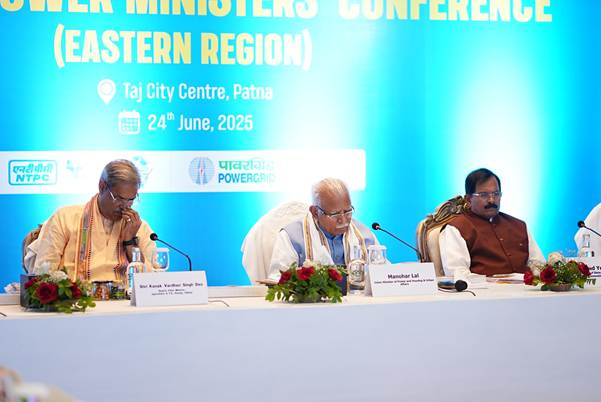Eastern Regional Power Conference Charts Path for Sustainable, Resilient Growth
India has achieved remarkable progress in recent years, transforming from a power-deficit to a power-sufficient nation.

- Country:
- India
The Regional Conference for Eastern Region States and Union Territories, held on 24th June 2025 in Patna, convened top policymakers, energy ministers, and industry leaders to deliberate on the future of India’s power sector. Chaired by Union Minister of Power and Housing & Urban Affairs Shri Manohar Lal, the conference brought together stakeholders from Bihar, Jharkhand, Odisha, and key central agencies to address critical issues in generation, transmission, distribution, renewables, and power sector reforms.
In his keynote address, Shri Manohar Lal emphasized that the conference reflects India’s unified commitment to “Power for All, at All Times”, and called for a collaborative approach between the Centre and States to realize the vision of Viksit Bharat by 2047.
From Power-Deficit to Power-Surplus: A National Milestone
India has achieved remarkable progress in recent years, transforming from a power-deficit to a power-sufficient nation. The Union Minister announced that:
-
Peak power demand touched 250 GW in May 2024 and 242 GW in 2025 so far
-
Demand is expected to reach 270 GW by end-2025 and 446 GW by 2034–35
This steep rise highlights the need for long-term planning, resource adequacy, and enhanced generation and transmission capacity.
Resource Adequacy and Nuclear Power: A New Energy Mix
Calling for a balanced energy mix, Shri Manohar Lal stressed that states must:
-
Prepare Resource Adequacy Plans aligned to national goals
-
Ensure tie-ups for future power generation capacities
-
Include nuclear power in their generation mix
-
Explore setting up at least one nuclear power project per state
He reaffirmed India’s target of achieving 100 GW of nuclear power capacity by 2047 as a strategic imperative for energy security and clean energy leadership.
Strengthening Transmission Infrastructure
The Minister highlighted the importance of intra-state and inter-state transmission development, urging states to:
-
Resolve Right of Way (RoW) issues
-
Utilize diverse funding avenues such as:
-
Listing of transmission utilities
-
Multilateral financing
-
Tariff Based Competitive Bidding (TBCB)
-
Regulated Tariff Mechanisms (RTM)
-
Support from ₹1.5 lakh crore interest-free loans under Union Budget 2025–26
-
The forest clearance delays and bureaucratic bottlenecks impacting transmission were also addressed.
Renewable Energy and Storage: A Clean, Reliable Grid
Shri Manohar Lal outlined India’s clean energy ambitions:
-
Share of renewables in total power capacity has grown from 32% in 2014 to 49% in 2025
-
States must reinforce Renewable Purchase Obligation (RPO) targets
-
Promotion of energy storage systems (ESS) alongside solar and wind
-
Accelerated implementation of PM KUSUM and PM Surya Ghar Muft Bijli Yojana
Minister of State for Power and Renewable Energy, Shri Shripad Yesso Naik, urged states to complete PM KUSUM projects by December 2025, and fast-track adoption of rooftop solar initiatives.
Distribution Sector Reforms: A Critical Focus Area
The Union Minister identified the distribution sector as the weakest link in the power value chain. Challenges include:
-
High AT&C (Aggregate Technical & Commercial) losses
-
Wide gap between Average Cost of Supply (ACS) and Average Revenue Realized (ARR)
-
Delayed subsidy disbursal and unpaid government dues
-
Poor implementation of cost-reflective tariff structures
He called on states to:
-
Work closely with State Electricity Regulatory Commissions (SERCs)
-
Ensure timely true-up and tariff revisions
-
Improve billing and collections
-
Optimize discom finances through better subsidy targeting and accounting
Smart Metering and Digital Grid Transformation
To modernize power consumption and payment systems, Shri Manohar Lal emphasized the expedited rollout of prepaid smart meters, noting:
-
Smart meters unlock data analytics, AI/ML-based insights, and real-time consumption monitoring
-
States must saturate prepaid smart meters in all government offices and colonies by August 2025
-
Commercial and Industrial (C&I) consumers to be covered by November 2025
The Revamped Distribution Sector Scheme (RDSS) remains the backbone of this transformation, supported by infrastructure investments and central assistance.
Cybersecurity and Grid Resilience
In the context of growing cyber threats to national infrastructure, the Minister stressed:
-
Adoption of cybersecurity protocols across transmission and distribution networks
-
Implementation of Power Islanding Schemes to isolate and protect vital grid nodes during cyber incidents or attacks
-
Increased investment in real-time grid resilience technologies
States were urged to form dedicated cybersecurity task forces and coordinate with central agencies to bolster their cyber defense.
Sector Financing and Future Investment Needs
India’s power sector is projected to require investments of ₹42 lakh crore by 2032. The Minister advocated for:
-
Greater financial discipline among utilities
-
Commercialization of assets to raise capital
-
Public-private partnerships (PPPs) in generation, storage, and distribution
-
Optimal utilization of budgetary allocations and loan schemes
States were also encouraged to monetize existing power infrastructure to fund new capital projects.
A Collective Vision for Viksit Bharat
Union Power Secretary reiterated that energy is central to India’s development, and emphasized:
-
Urgent capacity tie-ups to meet FY2035 projections
-
Cyber-resilient infrastructure development
-
Strengthened collaboration between Centre, States, and utilities
Senior ministers including Shri Bijendra Prasad Yadav (Bihar), Shri Kanak Vardhan Singh Deo (Odisha), and Shri Sudivya Kumar (Jharkhand) engaged in detailed discussions on state-level challenges and opportunities.
Powering the Future Through Unified Action
The Regional Power Conference in Patna served as a vital platform for advancing the goals of energy security, sustainability, and economic resilience. With clear calls to action, shared commitments, and concrete timelines, the Centre and Eastern States have taken a significant step toward ensuring Power for All, at All Times, as a cornerstone of Viksit Bharat 2047.










